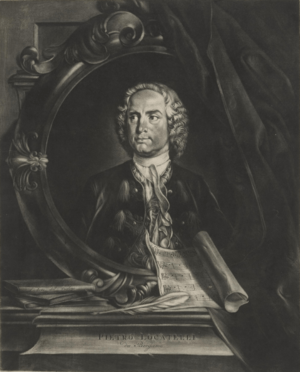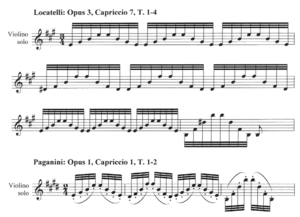Pietro Locatelli facts for kids
Pietro Antonio Locatelli was a famous Italian composer and violinist from the Baroque period. He was born on September 3, 1695, in Bergamo, Italy, and passed away on March 30, 1764, in Amsterdam.
Contents
Biography
Early Life in Bergamo
We don't know much about Locatelli's childhood. When he was young, he worked as the third violinist at the church of Santa Maria Maggiore in Bergamo. He was called a virtuoso, which means he was a very skilled musician. His first violin teachers were probably Ludovico Ferronati and Carlo Antonio Marino. The church's music director, Francesco Ballarotti, might have taught him how to compose music. In 1711, Locatelli moved to Rome to become more recognized.
Time in Rome
Locatelli started studying music in Rome in the autumn of 1711. He likely learned from Antonio Montanari or Giuseppe Valentini. He might have even studied for a short time with the famous Arcangelo Corelli, who died in 1713.
By 1714, Locatelli was a member of Prince Michelangelo I Caetani's group of household musicians. He also joined a special group for musicians called the congregazione generale dei musici di S. Cecilia. This group was protected by a powerful church leader named Camillo Cybo, who later became a Cardinal. Locatelli also played for other important Roman families, including Cardinal Pietro Ottoboni.
While in Rome, Locatelli started publishing his own music. In 1721, his XII Concerti grossi, Op. 1, was published in Amsterdam. He dedicated this work to Camillo Cybo.
Travels in Italy and Germany
From 1723 to 1728, Locatelli traveled a lot through Italy and Germany. We know he visited cities like Mantua, Venice, Munich, Dresden, Berlin, Frankfurt, and Kassel. He probably wrote most of his concertos and violin pieces, called capricci, during this time. These were published later in Amsterdam.
People believed his performances made him famous, but there aren't many records proving how incredibly skilled he was. In Mantua, a document from 1725 called him "our virtuoso." We don't know how often he played there. He also definitely visited Venice, but the details are unclear.
In Munich, on June 26, 1727, Locatelli was paid a good amount of money for his performance. A year later, in May 1728, he visited the Prussian court in Berlin. He traveled with a large group, including other famous musicians. One story says that Locatelli was very confident and wore fancy, diamond-covered clothes when he played for King Frederick William I. However, some listeners might have preferred another violinist, Johann Gottlieb Graun.
Records show that Locatelli was in Frankfurt on October 20, 1728. His last known stop was in Kassel, where he received a very high payment of 80 reichsthaler after playing for Charles I, Landgrave of Hesse-Kassel, on December 7, 1728. An organist named Jacob Wilhelm Lustig said that Locatelli amazed his audience with incredibly difficult violin passages.
Life in Amsterdam
In 1729, Locatelli moved to Amsterdam and lived there until he died. He didn't compose as much as before, but he gave violin lessons to people who played for fun, not as professionals. He also edited his own works (Opp. 1–9) and music by other musicians.
His public performances were usually only for music lovers, not for other professional musicians. An Englishman who heard him in 1741 wrote that Locatelli was "so afraid of People Learning from him, that He won't admit a Professed Musician into his Concert." Some wealthy music lovers helped him become rich by playing with him. He was a respected and admired musician and composer among the wealthy. In 1741, he even started a business selling violin strings from his home. In 1742 alone, he earned about 1500 guilders, which was the highest income for any musician in Amsterdam.
Locatelli died on March 30, 1764, in his house on the Prinsengracht.
Locatelli's Legacy
After Locatelli died, his large library was discovered. It had over a thousand books on many different subjects, including birds, religion, history, politics, geography, art, and math. He also owned many important books by famous writers like Dante. His collection also included all the works of Corelli and paintings by Dutch, Italian, and French artists. All these items, along with his musical instruments, were sold at an auction in August 1765.
Music
When Locatelli moved to Amsterdam in 1729, he found a major center for music publishing in Europe. He published many of his works there, including Opp. 2–6, 8, and 9. He also released a new edition of his Op. 1. His Op. 7 was published in the nearby city of Leiden. He was very careful to make sure his published music was perfect.
Locatelli's earlier works include Op. 1, Op. 3, and parts of Opp. 2 and 4 to 8. He obtained a special legal "privilege" that protected his works (Opp. 1–8) from being copied without permission. This also stopped unauthorized copies from being brought into Holland. Because of this privilege, Locatelli had to give free copies of his first prints to the Leiden university library, which is why some of his original works are still preserved today. Op. 9 was published after this legal protection had ended.
Locatelli's music can be put into three main groups:
- Music he wrote to show off his own amazing violin skills.
- Grand pieces for larger groups of musicians.
- Smaller, more intimate pieces for small groups.
Examples of his show-off pieces are the Violin Concertos Op. 3, which include 24 special solo sections called Capricci, and the Violin Sonata Op. 6. These works, especially Op. 3, were very important for violin players and made him famous across Europe. The Capricci were meant for practicing and studying difficult techniques, not usually for public concerts. Musicians like Niccolò Paganini probably learned about Locatelli's music through French violin schools. Paganini's famous Capriccio Op. 1, Nr. 1, is quite similar to Locatelli's Capriccio Nr. 7.
Locatelli's amazing violin skills are clear in his Capricci. He used very high notes, played two notes at once (called double stopping), and used chords and fast arpeggios that required wide stretches of the left hand. He also used harmonics (lightly touching the string to create a high, clear sound), trills (quickly playing two notes back and forth) in two parts at once (like in the famous Trillo del Diavolo), and many different ways of using the bow.
Locatelli's Concerti Op. 1, Op. 7, and some from Op. 4 were inspired by Corelli's Twelve concerti grossi, Op. 6. His Introduttioni teatrali Op. 4 followed the style of the Neapolitan opera sinfonia, which was a type of orchestral opening for operas.
His Flute Sonatas, Op. 2, the Trio Sonatas, Op. 5, and the Violin Sonatas and Trio Sonatas, Op. 8, were very popular in Amsterdam. They fit well with the city's love for lighter, more modern music of the time.
Works
- Op. 1 (1721) – XII Concerti grossi à Quattro e à Cinque, (12 concertos for four or five parts: in F, C minor, B flat, E minor, D, C minor, F, F minor, D, C, C minor, G minor)
- Op. 2 (1732) – XII Sonate à Flauto traversiere solo e Basso, (12 flute sonatas: in G, D, B flat, G, D, G minor, A, F, E, G, D, G)
- Op. 3 (1733) – L'Arte del Violino; XII Concerti Cioè, Violino solo, con XXIV Capricci ad libitum, (12 violin concertos with 24 Capriccios you can play if you want: in D, C minor, F, E, C, G minor, B flat, E minor, G, F, A, D "Il laberinto armonico")
- Op. 4 (1735) – VI Introduttioni teatrali e VI Concerti, (6 theatrical Introductions: in D, F, B flat, G, D, C and 6 concertos: in D, F, G, Eb, C minor, F)
- Op. 5 (1736) – VI Sonate à Trè, (6 trio sonatas: in G, E minor, E, C, D minor, G "Bizarria")
- Op. 6 (1737) – XII Sonate à Violino solo e Basso da Camera, (12 violin sonatas: in F minor, F, E, A, G minor, D, C minor, C, B minor, A minor, E flat, D minor)
- Op. 7 (1741) – VI Concerti à quattro, (6 four-part concertos: in D, B flat, G, F, G minor, E flat)
- Op. 8 (1744) – X Sonate, VI à Violino solo e Basso e IV à Trè, (6 violin sonatas: in F, D, G minor, C, G, E flat; and 4 trio sonatas: A, D, F minor, A)
- Op. 9 (1762) – VI Concerti a quattro (6 four-part concertos), Amsterdam 1762
- Works without an opus number:
- Sonata in G minor, for violin and b.c. (a type of bass accompaniment)
- Sinfonia [...] composta per l'esequie della sua Donna che si celebrarono in Roma F minor, for 2 violins, viola and b.c.
- Concerto A major, for violin, 2 violins, viola and b.c.
- Concerto E major, for violin, 2 violins, viola and b.c.
- Opera dubia (Doubtful works): These are pieces that might be by him, but we're not sure. They include violin concertos, symphonies, a trio sonata, flute duets, an oboe sonata, and a capriccio in E for violin.
- Many other works of different types have been lost over time.
See also
 In Spanish: Pietro Locatelli para niños
In Spanish: Pietro Locatelli para niños





